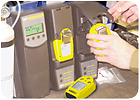
Workers using gas monitors must have confidence in their performance. A functional test prior to each day’s use is considered the safest and most effective way to validate a gas monitor.
But questions surrounding bump testing abound. How often is “periodic” or “frequent”? Is a monitor with a 180-day calibration interval better than one recommending 30 days? What do OSHA and other governing agencies require?
The fact is thereisno one size fits all answer. Sensor technology, applications and functions of the monitor must be considered.
Sensor specifics
Sensor technologies used in today’s gas monitors have improved significantly over the last decade. Advances such as electrochemical over solid state, enhanced poison resistance and less cross-interference have resulted in more reliable performance. This evolution is one reason why calibration intervals have lengthened. Still, gas monitors are not impervious to damage, and proper bump testing and verification of accuracy between calibrations can prevent a false sense of security.
Testing frequency may depend on the monitor itself. Most, if not all, confined space monitors used today are direct reading and detect for oxygen, LEL (lower explosive level), H2S and CO at a minimum. Catalytic bead combustible sensors are particularly prone to contamination that inhibits response to the target gas. Oxygen sensors are also prone to failure where they do not respond to atmospheric changes. Monitors that employ these sensors should be tested prior to each day’s use.
Some monitors are non-direct reading and maintenance free. They are not designed to be calibrated but can electronically compensate for the average degradation in sensitivity over the life of the monitor (2 percent loss per month). Typical application for these monitors is in the oil and gas industry where a single gas, such as H2S, is a major hazard. Most sensors used in this application are field proven sensors, which are not prone to the failure mechanisms for which explosive or oxygen sensors are known. In addition, manufacturers can design these monitors with a robust sensor integrity check that can detect internal failure modes.
Given these factors, some manufacturers choose to recommend periodic or frequent testing, as opposed to before each day’s use. The end-user can define a sensible frequency for bump tests, but it should never exceed 30 days, according to the International Safety Equipment Association.
ISEA weighs in
In May 1996, ISEA published a statement to ensure definition consistency in all documentation and to emphasize the need to verify calibration when using portable gas monitors in confined spaces. It was revised in November 2002 and can be downloaded atwww.safetyequipment.org/calibration.PDF.
The statement emphasizes the importance of verifying the calibration of instruments used to monitor potentially hazardous atmospheres, clarifies the differences between a functional (bump) test and a full calibration, and outlines when daily bump tests are needed and when less frequent tests may be appropriate. Gas detection equipment manufacturers have widely adopted ISEA’s statement.
In 2004, OSHA posted this ISEA statement on its Web site as a “Safety and Health Information Bulletin.” OSHA stipulates that this is not a regulation but is advisory in nature.
Testing redefined
The ISEA statement clarifies the difference between a functional (bump) test and a full calibration:
a)A functional (bump) test is defined as a means of verifying calibration by using a known concentration of test gas to demonstrate that an instrument’s response to the test gas is within acceptable limits.
b)A full calibration is defined as the adjustment of an instrument’s response to match a desired value compared to a known concentration of test gas.
Currently, ISEA is considering breaking this into three definitions. Much of the bump testing being carried out does not include verification of accuracy but, rather, is a qualitative test based on sensor response and activation of alarms. A 2007 revision is anticipated to include the three methods now used:
a) Bump test— A functional check involving the passing of a challenge gas over the sensors sufficient enough to activate audio, visual and other alarms.
b) Calibration check— A bump test utilizing a known concentration of a challenge gas to demonstrate that an instrument’s response to the gas is within acceptable limits.
c) Full calibration— Adjustment of an instrument’s response to match a desired value compared to a known concentration of test gas.
Frequency guidelines
ISEA’s statement goes on to recommend the frequency for verification of calibration:
a) A functional (bump) test or full calibration of direct reading portable gas monitors should be made before each day’s use in accordance with the manufacturer’s instructions using an appropriate test gas.
b) Any instrument that fails a functional (bump) test must be adjusted by means of a full calibration procedure before further use.
c) If environmental conditions that could affect instrument performance are suspected to be present, such as sensor poisons, then verification of calibration should be made on a more frequent basis.
Finally, the statement identifies circumstances under which itmaybe appropriate to lengthen the interval between verification tests.
Verifying proper performance is an essential part of any gas monitoring safety program. Following this protocol will ensure confidence in the workers as well as everyone responsible for keeping them safe.